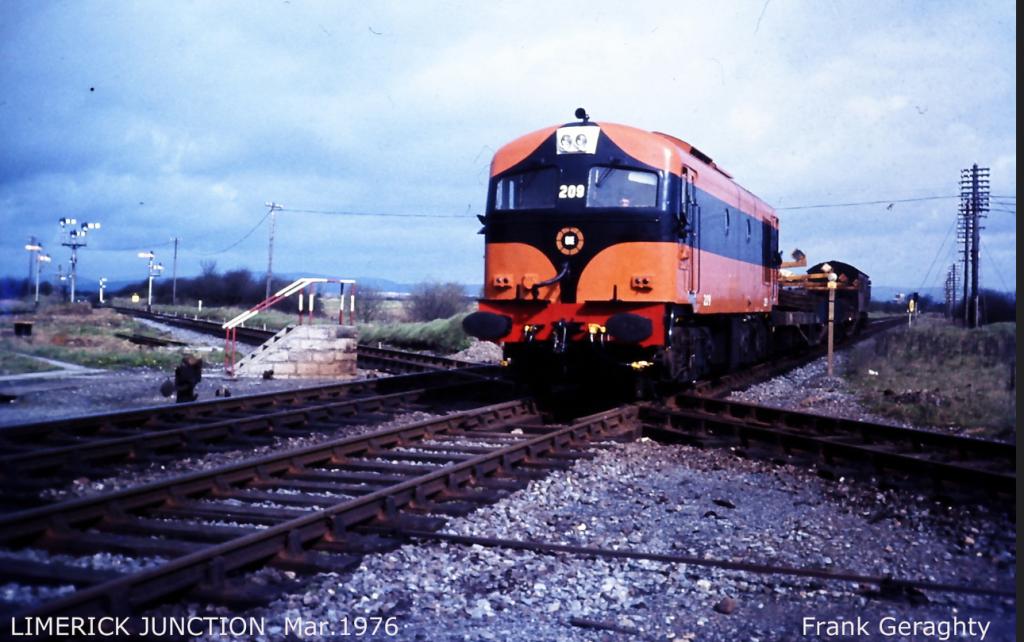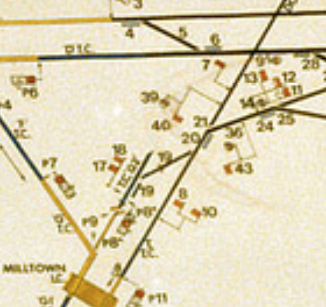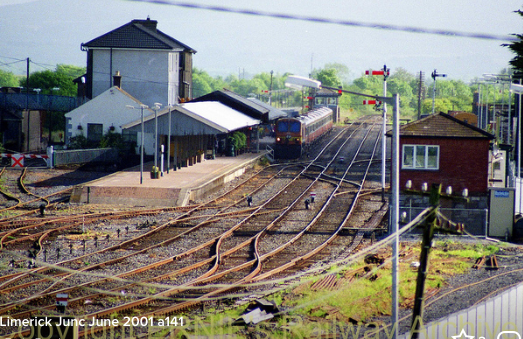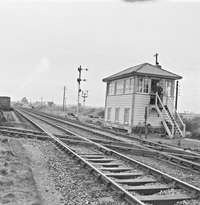
Junctionmad
-
Posts
1,136 -
Joined
-
Last visited
-
Days Won
1
Content Type
Profiles
Forums
Resource Library
Events
Gallery
Blogs
Store
Community Map
Posts posted by Junctionmad
-
-
If its the signal arms you are referring to, all IE signal arms are of that orange/reddish colour. They began painting them that luminous colour back in the early 1960s, moving away from the traditional standard red colour. More recently the texture used became more brighter and reflective to make the best of visibility from train headlights. Some arms though have faded by way of the sun and weathering, so there's sometimes an inconsistency in the shade.
Hmmm I have seen in the 80 s both types on the same post , one a brighter standard signal red the other a faded orange. You think the orange was by design. I often wondered did it denote a signal of lessor importance, could be passed with caution
-
Noel, the coaches you remember travelling in were steel panelled coaches (i.e. steel panels on a timber frame, commonly referred to in the media as 'wooden bodied coaches') not laminates. The SSM coach you link to is a model of a GSR-built Bredin-designed composite class coach. The vehicles built by CIÉ up to the introduction of the Park Royals (i.e. 1339 - 1378) were based on these coaches and were sometimes referred to as 'Bredins', although the CIÉ design was a development of the GSR design, the main difference being n increase in the carriage length from 60' 0" to 61' 6". The laminates, which came after the Park Royals were not based on the GSR Bredin stock but were a development of the Park Royals designed vehicles, being of the wider 10' 2" width. The principal differences between the laminates and the Park Royals were a smoother outline and the 10' 2" width being carried through to the ends of the vehicles.
The laminated came after the park royals. ? I taught it was the other way round , was it not lam->park royal -> craven
-
Picture found on the Internet. Seems to be the signal in question, caption reads:- A pre-1925 Great Southern & Western Railway semaphore signal at Limerick Jct, controlling Limerick to Waterford
More correctly it controlled the exit from the loop so I suspect it's in effect an outer home signal
-
I notice a lot of signals had that orange type coloring. The reversing /call on signal on platform 4 was clearly of that orange type. Is it just faded red , I notice most of these were then painted a brighter " signal red"
By the way we still haven't established when the lower semaphores of the other signals went to shunt signals 83 I beleive is when the up line gantry went in.
-
Would have been at the same time as CTC was extended through to Limerick, (from memory end of 1986?). One end of the pocket loop ended up in CTC territory, the other stayed within LJN's patch. The loop would only rarely have seen a crossing train by then, so full running signals weren't really needed. Shunt signals catered for freight reversal and running around from the Limerick end.
The starting signals from the Pocket loop towards Waterford are, in my view, as Snapper describes. An old semaphore practice was to have arms one above the other, rather than a bracket, particularly where space was tight or speeds were low, and you didn't need to see the relative positions on brackets from afar to safely pass the signals. In such cases, the convention is arms top to bottom, read to routes left to right. Normal signals are cheaper than brackets - money talks.
Semaphore arms for me it is then !
 I agree, with CTC, I think also thats when the gantry colour light light appeared at the end of platform 1 , displacing a ground mounted version
I agree, with CTC, I think also thats when the gantry colour light light appeared at the end of platform 1 , displacing a ground mounted version -
[ATTACH=CONFIG]14935[/ATTACH]
Heres a nice shot from 2001, interesting the tall signal to the right is the down signal, yet its actually position next to a siding
The tall signal would be in that position for sighting purposes for a train approaching round the L/H bend from the South
The down signal is presumably sited next to a siding and high to allow it to be seen approaching from the North not the south
Equally the inner home signal beside the South box, its actually situated beside the DOWN line, even though its refers to the UP line. I was always of the opinion that signals were sited next to the track they referred to , but clearly not in these cases
-
Junctionmad, in the Mar 1976 in your post both 36 and 39 signals are small sized semaphore signals (as was common practice) reading into the 'Pocket' loop. In the first pic in Snapper's post #54 they are both shunt signals. Snapper do you know when the photos you posted were taken? Given the presence of hi-viz vest in one of the pics I'd guess post-1976. It would be interesting to know if the signals were changed from semaphores to shunt signals as this would seem to indicate a downgrading of the loop.
Given its around the period Im interested , I do wonder when they were changed to shunt signals too, hard to tell.
-
My reading of that would be 18 would allow you to go as far as 7 and
17 would allow you to go to 11,12,13 signal post. and 39 does look like a shunt signal.
Amazing all is revealed when you search the net
 39 isn't a shunt per say , just a starting signal for the loop
39 isn't a shunt per say , just a starting signal for the loopInteresting semaphore 36 was removed in later years , yet visible in this photo
Im drooling at the model signal opportunities
-
My reading of that would be 18 would allow you to go as far as 7 and
17 would allow you to go to 11,12,13 signal post. and 39 does look like a shunt signal.
Funny its not on a gantry?
-
-
-
-
snapper, thanks, Ill review the signalling photos I have , I think I can see the "next" signal in all cases.
-
Thanks, sorry I do understand quite a bit, what I don't understand about three aspect lights that are used as home signals, is the "caution", usually "caution" meant the next signal was red, but where there isn't a "next signal" what did caution mean ?
-
-
Can someone help me in interpreting these signal layouts. Im not an expert on colour light and its seems from the installation of the direct curve, most of the north box was converted to colour light.
Whats the purpose of the three aspect lights that seems to be indicated on these diagrams, was the third colour yellow, any photos of a typical CIE colour light of the time. Studioscale seem to have a design, is that representative
I understand the third colour was white, from the top was it green white red , what did white mean !
Thanks , Im lost with coloured lights
-
Thanks snapper, I have a later shot of the signal board, and that board only covers half the station
-
To me it looks like it was done to prove sufficient signaling overlap / protection so that a train from Dublin could be signaled into the direct curve at the same time a train was signaled into Limerick Junction from Limerick.
Not sure how that would work, I mean the direct curve joins the passing loop very near the limerick end, effectively forcing trains to hold on the direct curve, and there is evidence that on occasion that was done ( IPRS rail tour for example) I can't really see what the passing loop was for, other then to provide a Limerick to Junction train to wait for a train the opposite way to get by. i.e. its was a passing loop for the Limerick line rather then anything specific to the "direct curve"
-
Fantastic picture resource. Thank you very much Funny they didn't get the same detail inside the south cabin ( but I found another one for that )
The diagram confirms my memory that the outer signals on the Dublin side were a mix of semaphore and colour light by the late 70s
I think I can start that track and signal plan now
Any info much appreciated
PS when I mentioned the moving of the north cabin I meant like 20-30 feet. But it could be just illusion
Anyone have a picture of the signal board in the south cabin around the period in question
-
Only because there was no political insight to create a high-speed rail network linking major centers, decentalizing Dublin, linking the country, creating further employment, while the Celtic Tiger coffers were full...... did I just verbalize all that in black and white?

Actually I disagree with high speed, much as I love railways. The case for ANY mainline heavy rail in a small under populated country
Ike Ireland is futile. High speed lines simply make no sense over such distances , knocking 10-15 minutes off a journey to cork isn't going to solve IRs falling numbers
The fact is motorways are cheaper, more convenient and faster over such short distances. Rail transport and especially IR s version of it will never be a practical or attractive option. IRs attempt to turn the railway carriage into a kind of glorified bus , just makes ... People use buses.
At this stage it's hopeless. It's in a death spiral, look at the capital purchases, which are all " political" in nature , the Mk3 had years left in them, and could have been nicely refurbished , the engine population was more then adequate , then we suddenly had deDitrich stock and railcars, primarily justified by the " boo who " look at the money roads are getting , give us some , political nonsense
-
Yep, we lost the plot in the 60s , everything old had no value , remember those diy articles that suggested covering up 6 panelled solid timber doors and , banisters with sheets of Formica , to " give a modern smooth clean appearance " god in heaven we were stupid ......
-
Yes IR , if it had less branding and more focus on what passengers want , ........
-
-
One wonders what was behind the thinking at miltown and the way the direct curve attached to the limerick line , were they anticipating a double track arrangement that was being mooted for Limerick around that time ?
.png.c363cdf5c3fb7955cd92a55eb6dbbae0.png)








Cleaning track?!
in Questions & Answers
Posted
I second that. That's the only way to condition dirty track , the meths/IPA is only good once the track is basically bright clean